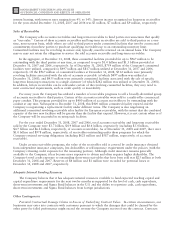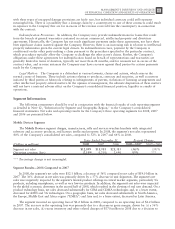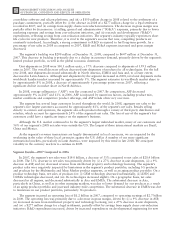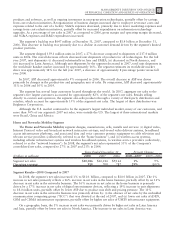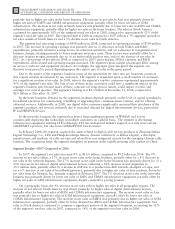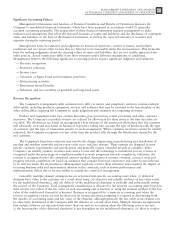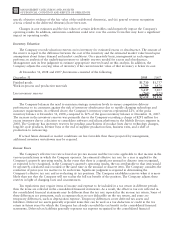Motorola 2008 Annual Report Download - page 67
Download and view the complete annual report
Please find page 67 of the 2008 Motorola annual report below. You can navigate through the pages in the report by either clicking on the pages listed below, or by using the keyword search tool below to find specific information within the annual report.
extend for periods of one to three years (three to five years for software). However, generally these agreements do
not obligate the Company to make any purchases, and many permit the Company to terminate the agreement with
advance notice (usually ranging from 60 to 180 days). If the Company were to terminate these agreements, it
generally would be liable for certain termination charges, typically based on work performed and supplier on-hand
inventory and raw materials attributable to canceled orders. The Company’s liability would only arise in the event
it terminates the agreements for reasons other than “cause.”
The Company outsources certain corporate functions, such as benefit administration and information
technology-related services. These contracts are expected to expire in 2013. At December 31, 2008, the total
remaining payments under these contracts are approximately $953 million over the remaining life of the contracts;
however, these contracts can be terminated. Termination would result in a penalty substantially less than the
remaining annual contract payments. The Company would also be required to find another source for these
services, including the possibility of performing them in-house.
As is customary in bidding for and completing network infrastructure projects and pursuant to a practice the
Company has followed for many years, the Company has a number of performance/bid bonds, standby letters of
credit and surety bonds outstanding (collectively, referred to as “Performance Bonds”), primarily relating to
projects of the Enterprise Mobility Solutions and Home and Networks Mobility segments. These Performance
Bonds normally have maturities of up to three years and are standard in the industry as a way to give customers a
convenient mechanism to seek resolution if a contractor does not satisfy performance requirements under a
contract. A customer can draw on the Performance Bond only if the Company does not fulfill all terms of a project
contract. If such an occasion occurred, the Company would be obligated to reimburse the financial institution that
issued the Performance Bond for the amounts paid. In its long history, it has been rare for the Company to have a
Performance Bond drawn upon. At December 31, 2008, outstanding Performance Bonds totaled approximately
$1.8 billion, compared to $1.7 billion at the end of 2007. As a result of the Company’s current credit ratings,
issuers of these Performance Bonds may be less likely to provide Performance Bonds on the Company’s behalf in
the future, unless the Company provides collateral. These limitations on issuance may apply to the renewal and
extension of existing Performance Bonds, as well as the issuance of new Performance Bonds. Such collateral
requirements could result in less liquidity for other operational needs. Also, as a result of the Company’s current
credit ratings, there has been an increase in the cost of issuance of Performance Bonds.
Off-Balance Sheet Arrangements: Under the definition contained in Item 303(a)(4)(ii) of Regulation S-K, the
Company does not have any off-balance sheet arrangements.
Long-term Customer Financing Commitments
Outstanding Commitments: Certain purchasers of the Company’s infrastructure equipment continue to
request that suppliers provide long-term financing, defined as financing with terms greater than one year, in
connection with equipment purchases. These requests may include all or a portion of the purchase price of the
equipment. However, the Company’s obligation to provide long-term financing is often conditioned on the issuance
of a letter of credit in favor of the Company by a reputable bank to support the purchaser’s credit or a pre-existing
commitment from a reputable bank to purchase the long-term receivables from the Company. The Company had
outstanding commitments to provide long-term financing to third parties totaling $370 million and $610 million at
December 31, 2008 and 2007, respectively. Of these amounts, $266 million and $454 million were supported by
letters of credit or by bank commitments to purchase long-term receivables at December 31, 2008 and 2007,
respectively. In response to the recent tightening in the credit markets, certain customers of the Company have
requested financing in connection with equipment purchases, and these types of requests have increased in volume
and scope. Motorola may increase its commitments to provide financing in light of these requests.
Guarantees of Third-Party Debt: In addition to providing direct financing to certain equipment customers,
the Company also assists customers in obtaining financing directly from banks and other sources to fund
equipment purchases. The Company had committed to provide financial guarantees relating to customer financing
totaling $43 million and $42 million at December 31, 2008 and 2007, respectively (including $23 million at both
December 31, 2008 and 2007 relating to the sale of short-term receivables). Customer financing guarantees
outstanding were $6 million and $3 million at December 31, 2008 and 2007, respectively (including $4 million
and $0 million at December 31, 2008 and 2007, respectively, relating to the sale of short-term receivables).
Outstanding Long-Term Receivables: The Company had net long-term receivables, less allowance for losses,
of $162 million and $118 million at December 31, 2008 and 2007, respectively (net of allowances for losses of
$7 million and $5 million at December 31, 2008 and 2007, respectively). These long-term receivables are generally
59
MANAGEMENT’S DISCUSSION AND ANALYSIS
OF FINANCIAL CONDITION AND RESULTS OF OPERATIONS













